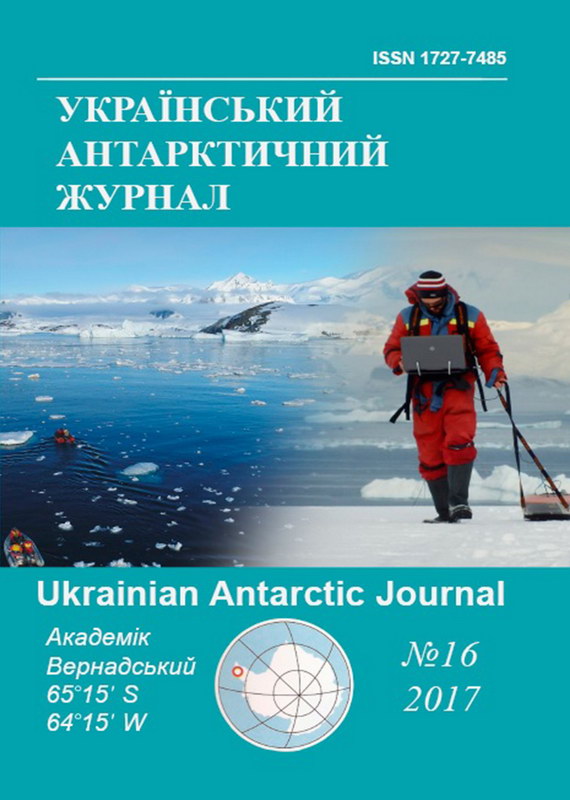- форма Sq варіацій,
- осінньо-весняна асиметрія,
- тренд добової амплітуди Sq

Ця робота ліцензується відповідно до Creative Commons Attribution-NonCommercial-NoDerivatives 4.0 International License.
Анотація
Просторова неоднозначність величини столітніх трендів добових амплітуд Sq варіацій визначила дослідження цього питання в районі від’ємних ВВ геомагнітного поля. Мета. Вивчення характеристик (трендів добових амплітуд і форми) сонячно-добових Sq варіацій на антарктичній обсерваторії AIA. Методи. Аналіз даних моніторингу геомагнітного поля на обсерваторії за період 1958-1991г. Виняток впливу залежності добової амплітуди Sq варіацій від індексу сонячної активності F10,7 із застосуванням методу залишків регресійного аналізу. Результати. З аналізу форми Sq варіацій були отримані сезонні особливості SqZ, SqY: осінньо-весняна асиметрія і додатковий ранковий екстремум в добовому ході Sq зимового (квітень-вересень) типу. Виявлено сезонні відмінності як середньомісячних значень добової амплітуди Sq варіацій, так і величин їх довгострокового тренда за 33 роки. Висновки. Виявлені позитивні тренди середньорічних добових амплітуд Sq варіацій склали 11% для східної SqY і 17-20% для вертикальної SqZ варіації. Спостережуваний при цьому розкид величини тренду річних амплітуд Sq, мабуть, обумовлений сезонними варіаціями фізичних параметрів, що визначають Sq.
Посилання
- Maksymenko, О.I., Bakhmutov, V.G., Kilifarska, N., Shevderovskaja, O.Ya. 2013. Trendovye izmenenija geomagnitnogo polja na observatorii "Argentinskie ostrova"- efect v Sq-variatsiiah [Trend changes in the geomagnetic field at the Argentine Islands observatory - effect in Sq-variations]. Ukrainskij Antarctychnyj Zhurnal [Ukrainian Antarctic Journal], 12, 62-68.
- Maksymenko, О.I., Shevderovskaja, O.Ya. 2014. Geomagnetnye solnechno-sutochnye variatsyi v Antarktike. Sviaz s solnechnoi aktivnostu [Geomagnetic solar-diurnal variations in the Antarctic. Relatioship with solar activity]. Ukrainskij Antarctychnyj Zhurnal [Ukrainian Antarctic Journal], 13, 67-74.
- Maksymenko, О.I., Shevderovskaja, O.Ya. 2015. Osobennosti formy solnechno-sutochnyh geomagnitnykh SqY-variatsii nad Antarktikoi [Features of the form of solar-daily geomagnetic SqY variations over the Antarctic]. Mezhdistsyplinarnye issledovaniia v nauke i obrazovanii [Interdisciplinary research in science and education], 3, H. mino.esrae.ru/hdf/2016/5sp/1541.doc
- Yaremenko, L.N., Mishchenko, Yu.P., Shevderovskaja O.Ya. 2004. Glavnoe magnitnoe pole i vekovye variatsii v predelakh zemli [The main magnetic field and age-old variations within the Earth's mantle]. Geofizicheskii zhurnal [Geophysical Journal], 26, 1, 117-122.
- Blas de Haro Barbas, B.F., Elias, A.Q. Cnossen I., Zossi de Artiqas, M. 2013. Lonq-term chanqes in solar quiet (Sq) qeomaqnetic variations related to Earth's maqnetic field secular variation. J. Geophys. Res. Space Physics, 118, .3712-3718. https://doi.org/10.1002/jgra.50352
- Cnossen, I., Richmond, A.D. Wiltberqer, M. 2011. The dependence of the coupled magnetosphere-ionospherethermosphere system on the Earth's magnetic dipole moment. J. Geophys. Res., 117, A05302. https://doi.org/10.1029/2012JA017555
- Cnossen, I., Richmond, A. D. 2013. Chanqes in the Earth's magnetic field over the past century: Effects on the ionosphere-thermosphere system and solar quiet (Sq) magnetic variation. J. Geophys. Res. Space Physics, 118, 849-858. https://doi.org/10.1029/2012JA018447
- Duma, Q. 2003. Ruzhin Diurnal chanqes of earthquake activity and geomaqnetic Sq-variations. Natural Hazards and Earth System Sciences, 3, 171-177. https://doi.org/10.5194/nhess-3-171-2003
- Kuvshinov, A.V. 2008. 3-D global induction in the oceans and solid Earth:Recent progress in modelinq magnetic and electric fields from sources of magnetospheric, ionospheric and oceanic origin. Surv. Geophys, 29, 139-186. https://doi.org/10.1007/s10712-008-9045-z
- Lukianova, R. and Christiansen, F., 2006. Modelinq of the global distribution of ionospheric electric fields based on realistic maps of field-aligned currents. J . Geopys.Res., 111, A3. https://doi.org/10.1029/2005JA011465
- Pedatella, N.M., Forbes, J.M. and Richmond, A.D. 2011. Seasonal and longitudinal variations of the solar quiet (Sq)current system during solar minimum determined by CHAMP satellite magnetic field observations. J. Geophys. Res., 116, A04317, https://doi.org/10.1029/2010JA016289
- Shinbori, et al. 2014. Lonq-term variation in the upper atmosphere as seen in the qeomagnetic solar quiet daily variation. Earth, Planets and Space, 66, 155. http://www.earth-planets-space.com/66/1/155. https://doi.org/10.1186/s40623-014-0155-1
- Steninq, R. J. 2008.The shape of the Sq current system. Ann. Geophys, 26, 1767-1775. https://doi.org/10.5194/angeo-26-1767-2008
- Steninq, R.J, Reztsova, T., Ivers, D., Turner, J. and. Winch, D. 2005. Morninq quiet-time ionospheric current reverсаl at mid to hiqh latitudes. Annales Geophysical, 23, 385-391. https://doi.org/10.5194/angeo-23-385-2005
- Steninq, R.J. and Reztsova, T. 2007. The daily variations of the vertical (Z) element of the Geomaqnetic field around the coast of mainland Australia. Earth Planets Space, 59, 579-584. https://doi.org/10.1186/BF03352720
- Takeda, M. 2002. Features of qlobal geomaqnetic Sq field from 1980 to 1990. J. Geophys. Res, 107, 4-8. https://doi.org/10.1029/2001JA009210
- Takeda, M. 2013. Difference in seasonal and lonq-term variations in geomaqnetic Sq fields between geomagnetic Y and Z components. J. Geophys. Res.: Space Physics, 118, 5, 522-2526. https://doi.org/10.1002/jgra.50128
- Thu H. Pham Thi, Amory-Mazaudier, C., Le Huy, M. 2011. Sq field characteristics at Phu Thuy, Vietnam, durinq solar cycle 23:comparisons with Sq field in other lonqitude sectors. Annales Geophysical, 29, 1-17. www.ann-geophys.net/29/1/2011/. https://doi.org/10.5194/angeo-29-1-2011
- Torta, J., Саntiaqo Marсаl,. Curto, Juan J et al. 2010. Behaviour of the quiet-day geomaqnetic variation at Livinqston Island and variability of the Sq focus position in the South American-Antarctic Peninsula reqion. Earth Planets Space, 62, 297-307. https://doi.org/10.5047/eps.2009.11.004
- Yamazaki, Y., Yumoto, K., Cardinal M. et al. 2011. An empirical model of the quiet daily geomagnetic field variation. J. Geophys. Res. 116, A10. https://doi.org/10.1029/2011JA016487
- Yamazaki and Yumoto. 2012. Lonq-term behavior of annual and semi-annual Sq variations. Earth Planets Space, 64, 417-423. https://doi.org/10.5047/eps.2011.01.014
- Yamazaki, Y., Kosch, M.J. 2014. Geomagnetic lunar and solar daily variations durinq the last 100 years. Journal of Geophysical Research: Space Physics, 119, 8. https://doi.org/10.1002/2014JA020203

